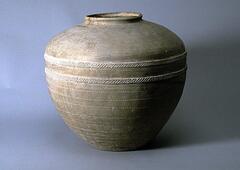17 UMMA Objects
17 UMMA Objects
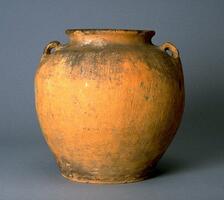
Chinese (Chinese (culture or style))
Jar
1046 BCE – 771 BCE
Gift of Mrs. Henry Jewett Greene for The Mr. and Mrs. Henry Jewett Greene Memorial Collection
1971/2.66

Korean (Korean (culture or style))
Storage Jar on cut-out pedestal foot
500 – 699
Gift of Bruce and Inta Hasenkamp and Museum purchase made possible by Elder and Mrs. Sang-Yong Nam
2004/1.174
![The gray jar with a little long neck has a foot with rectangular perforations and is potted with fine silt-based clay. The relatively thin mouth is slightly everted. Three deep incisions encircle the midsection of the neck. The globular body is decorated with two incised line encircled the body. The foot whose bottom is rolled outward is a little high and wide.<br />
<br />
The long and splayed neck of this blue-gray, high-fired stoneware jar is encircled by two sets of ridges. The set on the upper section of the neck has two ridges, and the set on the lower section has one ridge. The rim is narrow and round. The inner surface of the neck shows rough, uneven surfaces resulting from wheel throwing. The body is widest at its middle. The vessel surface has been smoothed by paring on a wheel after attaching the low pedestal. The pedestal shows six rectangular perforations.
<p>[Korean Collection, University of Michigan Museum of Art (2017) p. 51]</p>
The gray jar with a little long neck has a foot with rectangular perforations and is potted with fine silt-based clay. The relatively thin mouth is slightly everted. Three deep incisions encircle the midsection of the neck. The globular body is decorated with two incised line encircled the body. The foot whose bottom is rolled outward is a little high and wide.<br />
<br />
The long and splayed neck of this blue-gray, high-fired stoneware jar is encircled by two sets of ridges. The set on the upper section of the neck has two ridges, and the set on the lower section has one ridge. The rim is narrow and round. The inner surface of the neck shows rough, uneven surfaces resulting from wheel throwing. The body is widest at its middle. The vessel surface has been smoothed by paring on a wheel after attaching the low pedestal. The pedestal shows six rectangular perforations.
<p>[Korean Collection, University of Michigan Museum of Art (2017) p. 51]</p>](/media/W1siZiIsIjIwMjIvMDkvMjQvMWNyMzV3bGVrZ19kZWZhdWx0LmpwZyJdLFsicCIsInRodW1iIiwiMjQweDIwMCJdXQ?sha=7b00061238459019)
Korean (Korean (culture or style))
Storage Jar on cut-out pedestal foot
400 – 599
Gift of Bruce and Inta Hasenkamp and Museum purchase made possible by Elder and Mrs. Sang-Yong Nam
2004/1.176
![This bright grayish-blue stoneware jar consists of a round base, globular body and long flaring neck. Narrow single ridges encircle the middle part of the neck, dividing it into four sections. Each section is engraved with a wave pattern. The shoulder doesn’t have any pattern.<br />
<br />
This is a blue-gray, long-necked, high-fired stoneware jar. The horizontal ridge on the upper part of the long vessel neck marks the boundary between the neck and its inwardly curved mouth. The mouth slopes inward and has a sharp edge. The neck is divided into four sections by three horizontal ridges spaced at equal intervals, and each section is decorated by a wave design rendered with a comb with approximately ten teeth. The jar is widest at its upper-middle part, and the base is round with a slightly recessed center.<br />
[Korean Collection, University of Michigan Museum of Art (2017) p. 47]<br />
This bright grayish-blue stoneware jar consists of a round base, globular body and long flaring neck. Narrow single ridges encircle the middle part of the neck, dividing it into four sections. Each section is engraved with a wave pattern. The shoulder doesn’t have any pattern.<br />
<br />
This is a blue-gray, long-necked, high-fired stoneware jar. The horizontal ridge on the upper part of the long vessel neck marks the boundary between the neck and its inwardly curved mouth. The mouth slopes inward and has a sharp edge. The neck is divided into four sections by three horizontal ridges spaced at equal intervals, and each section is decorated by a wave design rendered with a comb with approximately ten teeth. The jar is widest at its upper-middle part, and the base is round with a slightly recessed center.<br />
[Korean Collection, University of Michigan Museum of Art (2017) p. 47]<br />
](/media/W1siZiIsIjIwMjIvMDkvMjQvM2M4cmF2ZmJ5OV9kZWZhdWx0LmpwZyJdLFsicCIsInRodW1iIiwiMjQweDIwMCJdXQ?sha=62bb2075b9e5bebe)
Korean (Korean (culture or style))
Storage jar with bands of incised wavy patterns at neck; lid missing
5th century
Museum purchase made possible by the Margaret Watson Parker Art Collection Fund
2003/1.384
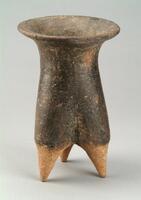
Chinese (Chinese (culture or style))
Tripod Jar
2200 BCE – 1600 BCE
Gift of www.silkroadtrade.com owners Seung Man Kim, Robert Piao, Daniel Shin and Hemin Quan
2003/2.22
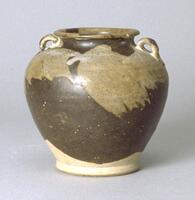
Chinese (Chinese (culture or style))
Small storage jar with two small loop handles
618 – 907
Museum Purchase
1950/2.14

Majiayao
Storage Jar with two handles and painted spiral design, from Gansu Province, China
7400 BCE
Museum Purchase
1959/2.84
![This grayish-blue stoneware jar has a globular body and short, a little flared neck. The surface of the body is encircled with a lot of thin incised lines. The base is a little flat.<br />
<br />
This is a dark gray, short-necked, high-fired stoneware jar with a flat bottom. The edge of the rim is round, and the inner surface of the neck is slightly tapered below the rim. The body is at its widest in the central part, while the flat base is rounded where it meets the body and is slightly indented at the edges. The entire body shows traces of rotation and water smoothing, with uneven surfaces resulting from rough water smoothing particularly visible on the lower part. The base also shows traces of having been pared and rubbed.
<p>[Korean Collection, University of Michigan Museum of Art (2017) p. 50]</p>
This grayish-blue stoneware jar has a globular body and short, a little flared neck. The surface of the body is encircled with a lot of thin incised lines. The base is a little flat.<br />
<br />
This is a dark gray, short-necked, high-fired stoneware jar with a flat bottom. The edge of the rim is round, and the inner surface of the neck is slightly tapered below the rim. The body is at its widest in the central part, while the flat base is rounded where it meets the body and is slightly indented at the edges. The entire body shows traces of rotation and water smoothing, with uneven surfaces resulting from rough water smoothing particularly visible on the lower part. The base also shows traces of having been pared and rubbed.
<p>[Korean Collection, University of Michigan Museum of Art (2017) p. 50]</p>](/media/W1siZiIsIjIwMjIvMDkvMjQvNTYwaTE4b3Jhel9kZWZhdWx0LmpwZyJdLFsicCIsInRodW1iIiwiMjQweDIwMCJdXQ?sha=992bf2faf4da912b)
Korean (Korean (culture or style))
Storage Jar with wide mouth and everted rim
6th century
Gift of Bruce and Inta Hasenkamp and Museum purchase made possible by Elder and Mrs. Sang-Yong Nam
2004/1.173
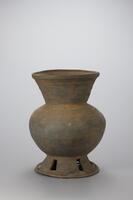
Korean (Korean (culture or style))
Large storage jar on cut-out pedestal foot
400 – 599
Gift of Bruce and Inta Hasenkamp and Museum purchase made possible by Elder and Mrs. Sang-Yong Nam
2004/1.185
![This grayish-blue stoneware jar has a globular body and short, a little flared neck. The entire surface of the body is adorned with vertical line and encircled with thin incised lines. The base is flat.<br />
<br />
This is a gray, bottle-shaped, high-fired vessel. It is covered entirely with parallel diagonal striations, and these have been erased in some parts by rubbing the surface from right to left. The neck, connected to the top of the body where it suddenly grows much narrower, flares widely toward the rim, which has a grooved edge. The body is widest at its middle, around which two thin horizontal lines are incised. The lower part of the outer surface has been pared during rotation. The base of the vessel is flat and has a recessed center.
<p>[Korean Collection, University of Michigan Museum of Art (2017) p. 75]</p>
<br />
<br />
This grayish-blue stoneware jar has a globular body and short, a little flared neck. The entire surface of the body is adorned with vertical line and encircled with thin incised lines. The base is flat.<br />
<br />
This is a gray, bottle-shaped, high-fired vessel. It is covered entirely with parallel diagonal striations, and these have been erased in some parts by rubbing the surface from right to left. The neck, connected to the top of the body where it suddenly grows much narrower, flares widely toward the rim, which has a grooved edge. The body is widest at its middle, around which two thin horizontal lines are incised. The lower part of the outer surface has been pared during rotation. The base of the vessel is flat and has a recessed center.
<p>[Korean Collection, University of Michigan Museum of Art (2017) p. 75]</p>
<br />
<br />
](/media/W1siZiIsIjIwMjIvMDkvMjQvNGV5bWdpZDc0N19kZWZhdWx0LmpwZyJdLFsicCIsInRodW1iIiwiMjQweDIwMCJdXQ?sha=ca86222f7dbccd76)
Korean (Korean (culture or style))
Small-mouthed storage jar with impressed cord design
6th century
Gift of Bruce and Inta Hasenkamp and Museum purchase made possible by Elder and Mrs. Sang-Yong Nam
2004/1.164
Loading…
